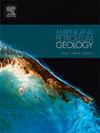Diagenetic evolution and cementation mechanism in deep Carbonate reservoirs: A case study of Dengying Fm. 2 in Penglai, Sichuan Basin, China
IF 3.6
2区 地球科学
Q1 GEOSCIENCES, MULTIDISCIPLINARY
引用次数: 0
Abstract
The Dengying Formation in the Penglai region of the Sichuan Basin is renowned for hosting high-quality dolomite reservoirs. However, the understanding of their formation mechanisms and spatial distribution patterns remains enigmatic. This study undertakes a comprehensive petrographic analysis of the second member of the Dengying Formation, primarily focusing on its burial history, reservoir characteristics, and an examination of the types, stages, and developmental patterns of cementation within the dolomite reservoir. This is achieved through the application of isotopic geochemistry, inclusion temperature analysis, and laser U-Pb dating. The findings reveal that cements within the second member of the Dengying Formation predominantly occur in pores and fractures, often exhibiting euhedral and subhedral morphologies. These cements also exhibit evidence of replacing original non-skeletal grains and micrites in semi-euhedral and other forms. Broadly, the cements can be classified into four types: calcium cement (the most abundant), dolomite cement, quartz, and pyrite. The formation of calcareous and siliceous cements closely aligns with the sedimentation and burial processes of the Dengying Formation as a whole. The early to late stages of early-middle diagenesis play a crucial role in the formation of dolomite within the second member. Notably, the degree of euhedral dolomite formation directly correlates with the specific diagenetic stage. Our research indicates that the development of high-quality reservoirs in deep-to-ultra-deep microbial dolomites is a result of complex multi-factor interactions and multi-stage discontinuous modifications, leading to strong heterogeneity within the reservoirs. Microbial dolomite carbonates inherently exhibit high initial porosity, with the favorable sedimentary facies serving as the fundamental basis for reservoir development. Dissolution processes during the syngenetic and quasi-syngenetic periods, in conjunction with epigenetic karstification, further augment porosity and expand the reservoir's capacity. During burial and deep burial stages, various acidic fluids play a pivotal role in preserving and modifying the early-formed pores. In the deep environment characterized by high temperature and pressure, microbial dolomite reservoirs undergo intricate diagenetic evolution and possess complex pore preservation mechanisms. Remarkably, even under exceptional ultra-deep conditions, high-quality microbial dolomite carbonate reservoirs can still develop and be preserved, presenting significant potential for oil and gas exploration.
深部碳酸盐岩储层的成因演化和胶结机制:中国四川盆地蓬莱登瀛2号地层案例研究2 in Penglai, Sichuan Basin, China
四川盆地蓬莱地区的登瀛层以蕴藏优质白云岩储层而闻名。然而,人们对其形成机理和空间分布模式的认识仍然是个谜。本研究对登瀛地层第二层进行了全面的岩相分析,主要侧重于其埋藏历史、储层特征以及白云岩储层内胶结类型、阶段和发育模式的研究。通过应用同位素地球化学、包裹体温度分析和激光铀-铅年代测定法来实现这一目标。研究结果表明,登瀛组第二层中的胶结物主要出现在孔隙和裂缝中,通常表现出八面体和亚八面体形态。这些胶结物还显示出以半正方体和其他形态取代原始非骨骼颗粒和微晶的证据。大体上,水泥可分为四种类型:钙质水泥(最多)、白云石水泥、石英和黄铁矿。钙质胶结物和硅质胶结物的形成与整个登瀛组的沉积和埋藏过程密切相关。早-中成岩作用的早-晚期阶段对第二层白云岩的形成起着至关重要的作用。值得注意的是,八面体白云岩的形成程度与特定成岩阶段直接相关。我们的研究表明,深-超深微生物白云岩优质储层的开发是复杂的多因素相互作用和多阶段不连续改造的结果,从而导致储层内强烈的异质性。微生物白云岩碳酸盐本身具有较高的初始孔隙度,有利的沉积面是储层开发的根本基础。共生期和准共生期的溶解过程以及表生岩溶化进一步增加了孔隙度,扩大了储层的容量。在埋藏和深埋阶段,各种酸性流体在保存和改变早期形成的孔隙方面发挥着关键作用。在以高温高压为特征的深部环境中,微生物白云岩储层经历了复杂的成岩演化,具有复杂的孔隙保存机制。值得注意的是,即使在特殊的超深条件下,高质量的微生物白云岩碳酸盐储层仍能发育和保存,为油气勘探提供了巨大潜力。
本文章由计算机程序翻译,如有差异,请以英文原文为准。
求助全文
约1分钟内获得全文
求助全文
来源期刊

Marine and Petroleum Geology
地学-地球科学综合
CiteScore
8.80
自引率
14.30%
发文量
475
审稿时长
63 days
期刊介绍:
Marine and Petroleum Geology is the pre-eminent international forum for the exchange of multidisciplinary concepts, interpretations and techniques for all concerned with marine and petroleum geology in industry, government and academia. Rapid bimonthly publication allows early communications of papers or short communications to the geoscience community.
Marine and Petroleum Geology is essential reading for geologists, geophysicists and explorationists in industry, government and academia working in the following areas: marine geology; basin analysis and evaluation; organic geochemistry; reserve/resource estimation; seismic stratigraphy; thermal models of basic evolution; sedimentary geology; continental margins; geophysical interpretation; structural geology/tectonics; formation evaluation techniques; well logging.
 求助内容:
求助内容: 应助结果提醒方式:
应助结果提醒方式:


